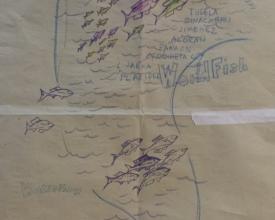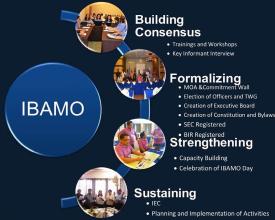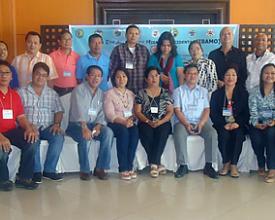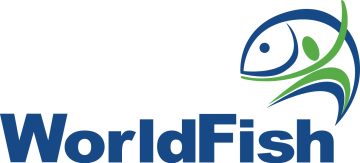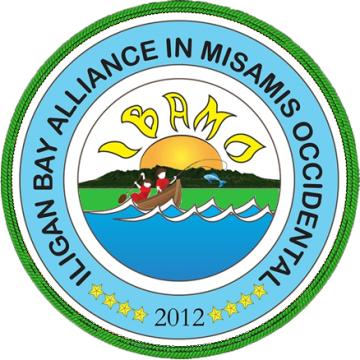Strengthening Governance of Small-Scale Fisheries Management
Full Solution
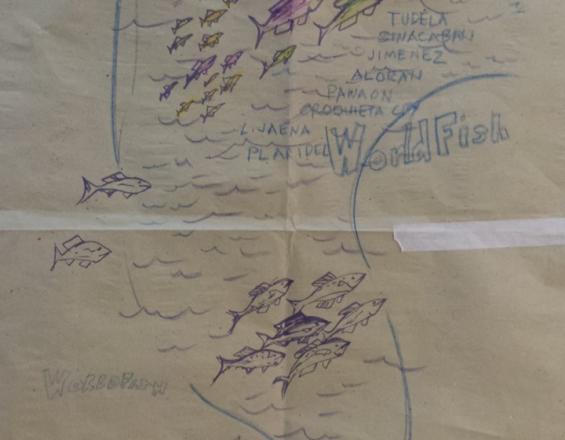
IBAMO Story Illustration (© IBAMO)
An Ecosystem Approach for Fisheries (EAF) was adopted by municipalities in Misamis Occidental, Philippines, to improve small-scale fisheries management for poverty reduction. They belong to Iligan Bay Alliance of Misamis Occidental (IBAMO), an initiative providing governance frameworks for LGU collaboration. It aims to be a proactive, committed, dynamic alliance for sustainable coastal resource development and seeks to foster the wellbeing of the environment and the people depending on fishing.
Last update: 28 Mar 2019
5017 Views
Context
Challenges addressed
neglections of ecosystem approaches in fisheries management and institutional arrangements
The solution aims to assess existing institutional arrangements and to understand how an EAF can overcome barriers to effective integrated SSF management. The Alliance develops EAF strategies and actions for SSF management suitable for developing country contexts and strengthens the capacity of local fishery stakeholders and government agencies to collaborate and work within an EAF.
Location
Misamis Occidental, Philippines
Southeast Asia
Process
Summary of the process
The solution was organized in two phases: (1) participatory diagnosis and identification of suitable strategies; (2) collaborative pilot implementation of fisheries management strategies in the focal sites. The participatory diagnosis used PDAM and complemented by RAFMS to define the fishery to be managed and to identify its specific, adressable issues. It was followed by mobilization of a management constituency that had the highest potential of addressing the issues prioritized. Eight coastal municipalities or local government units and the Province of Misamis Occidental were engaged to constitute IBAMO. Stakeholder workshops were conducted to build consensus and formalize the alliance. The research phase was essential to understand how governance initiatives can build on preexisting knowledge and to define the limits of what is possible. This phase culminated in the development of action plans for collaborative piloting the implementation strategies at focal sites. Inclusion of all target groups (mainly municipal development, agriculture and environment officers) in both phases aimed to strengthen their capacity to undertake diagnosis processes and to collaborate on implementation of strategies to improve governance of SSF.
Building Blocks
Participatory Diagnosis and Adaptive Management (PDAM)
The PDAM framework begins with a phase of diagnosis to define the fishery to be managed and to identify the specific issues to be addressed. Key tasks within the diagnosis phase include: (1) defining the fishery boundaries; (2) identifying fishery-specific challenges and opportunities (past, present & future); (3) prioritizing issues, (4) scoping potential management solutions.
Enabling factors
• Stakeholders deliberately consider who should be included in adaptive management.
Lesson learned
Mobilizing a management constituency that is best placed to address the threats and opportunities identified in the diagnosis phase is an essential step in legitimizing the EAF and increasing the potential for its success. Adaptive management then involves the negotiated design of integrated EAF and their subsequent implementation and assessment though IBAMO.
Rapid Appraisal of a Fisheries Management System (RAFMS)
The RAFMS approach was adopted to complement the PDAM in the participatory diagnosis. RAFMS focuses on fisheries management systems and considers the broader context of socio-economic, biophysical, and institutional dimensions. Results indicate five crucial issues to be addressed by IBAMO: (1) depleted fishery resources and low fish catch; (2) degraded fishery habitats; (3) lack of alternative livelihood; (4) limited institutional capabilities including lack of effective fisheries monitoring program; (5) lack of harmonization of fisheries laws and ordinances.
Enabling factors
• Stakeholders active participation in the stakeholder consultation; results from participatory diagnosis
Lesson learned
To verify the collected data, the summary and highlights of the results were presented and validated through a Stakeholder Consultation with participants of relevant provincial/city/municipal executives and key officials of Misamis Occidental.
Building Consensus and formalizing the Alliance
The formation of IBAMO is based on previous programs in the field of coastal resource management. Thus, building partnerships and consensus with “outside” institutions (including NGOs and civil society groups) and catalyzing the improvement of fisheries governance in the target sites was achieved within two years. In 2012, all eight LGUs entered and signed a new Memorandum of Agreement (MoA) to constitute IBAMO, along with the provincial government and regional offices of several government agencies Northern Mindanao.
Enabling factors
• strong commitment of the LGUs and Local Chief Executives beyond party lines
• the multi-stakeholder composition of IBAMO includes national government agencies
• “champions” from the LGUs - mostly the Municipal Planning and Development officers and/or Municipal Agriculture or Environment officers – who also serve as members of the Alliance’s technical working groups
• Provincial Government of Misamis Occidental serves as Secretariat
Lesson learned
• Building on past gains from similar project such as coastal resources management
• Building on existing institutions i.e., multi-agency governance arrangement, rather than creating new ones including presence of fishes organizations;
• Mobilizing support from national government agencies (e.g., BFAR, DENR, DOST) to link up with the LGUs and provides technical as well as financial support
• Partnerships with “outside” institutions (including civil society groups and academe) and catalyzing the improvement of fisheries governance in the target
Resources
Strengthening the Alliance and Capacity Building Activities
In order to strengthen the alliance, IBAMO has established five major committees facilitating its sustainable implementation:
• Information, Education and Communication Committee (IEC)
• Law Enforcement Committee
• Habitat Enhancement Committee
• Institutional/Capacity Building Committee
• Monitoring and Evaluation Committee
As part of the collaborative implementation of the EAF (i.e., pilot implementation of tailored strategies in focal sites with the explicit aim of capacity development of stakeholders for EAF), IBAMO was involved as key stakeholder. Capacity building focused on the institutional strengthening of IBAMO and included topics such as Coastal Resources Management, Fisheries Data Collection and other activities that were conducted in collaboration with other partners.
Enabling factors
• External institutions (including civil society groups) take a role in catalyzing the process fisheries improvement
• Mobilizing support from national government agencies (e.g., BFAR, DENR, DOST) to link up with the LGUs and provides technical as well as financial support.
Lesson learned
XXX YET MISSING XXX
Resources
Impacts
• Increased commitment to implement EAF in small-scale fisheries management through better understanding of its potential for poverty reduction and environmental sustainability
• Better integration of EAF and existing institutional arrangements in focal sites via the Coastal Resources Management plans of LGUs
• Enhanced understanding of the roles of MPAs to effectively implement EAF in the local context
• Active participation of final beneficiaries, including women, in participatory research and collaborative implementation of EAF strategies
• Capacity development of target groups (e.g. municipal development, agriculture and environment officer) through collaborative research and implementation of EAF strategies in project sites
• production and dissemination of practical guidelines for EAF action programs and policy recommendations for long-term planning
Beneficiaries
the empowerment of small-scale fisherfolk, women and local government units and societies
Story
The story of IBAMO can be compared to a “once upon a time” fairytale story that started from modest dreams and humble beginnings. The pictogram nicely illustrates the formation of IBAMO over time:
IBAMO started as an offshoot project output of the Philippine-Australia Community Assistance Program (PACAP) that implemented a focused community assistance projects in several municipalities under the province of Misamis Occidental. Under PACAP, the Iligan Bay Coastal Resource Management Development Project was implemented by four neighboring municipalities (Tudela, Sinacaban, Jimenez and Panaon). The four fishes at the bottom of the pictogram represent these LGUs with the fishes swimming in different directions. They had not yet developed their common vision, thus, the establishment of IBAMO was put on hold and the LGUs went on different directions and activities. Later on, WorldFish implemeted the USAID-WorldFish “From Ridge to Reef Project”, an ecosystem-based approach from Mt. Malindang to coastal communities covering six LGUs. The re-establishment of IBAMO was then again triggered by this project adding two additional municipalities – Aloran and Oroquieta City. As illustrated, the six fishes started to grow big and started to swim towards one direction.
By 2012, the European Commission (EC) and WorldFish implemented the “Ecosystem Approach to Fisheries in Small-Scale Tropical Marine Fisheries (EAF) Project” that supported the full establishment of IBAMO as an institutional complement to the ecosystem approach to coastal resource management. IBAMO member LGUs increased from six to eight, with the municipalities of Lopez Jaena and Plaridel joining the alliance. Through this project, the fishes gained more active colors. With signing of MoA between LGUs and institutional partners, the alliance was formally institutionalized. International partners of IBAMO, such as WorldFish and EC, provided institutional strengthening and capacity building activities to strengthen the alliance. IBAMO’s network of government and non-government institutions supported the alliance’s annual plans and programs technically and financially for activities like CRM certification, FISHR, color coding of municipal boats, conduct of IBAMO Day, IBAMO logo making contest and other R&D activities.
IBAMO had earned its bright colors through the help of WorldFish and the EC. And as the alliance swims towards bigger waves they hope to expand more their numbers in order to gain more strength.
Connect with contributors
Other contributors
Len R. Garces
WorldFish - Philippine Country Office
Dr. Maripaz L. Perez
WorldFish - Philippine Country Office
